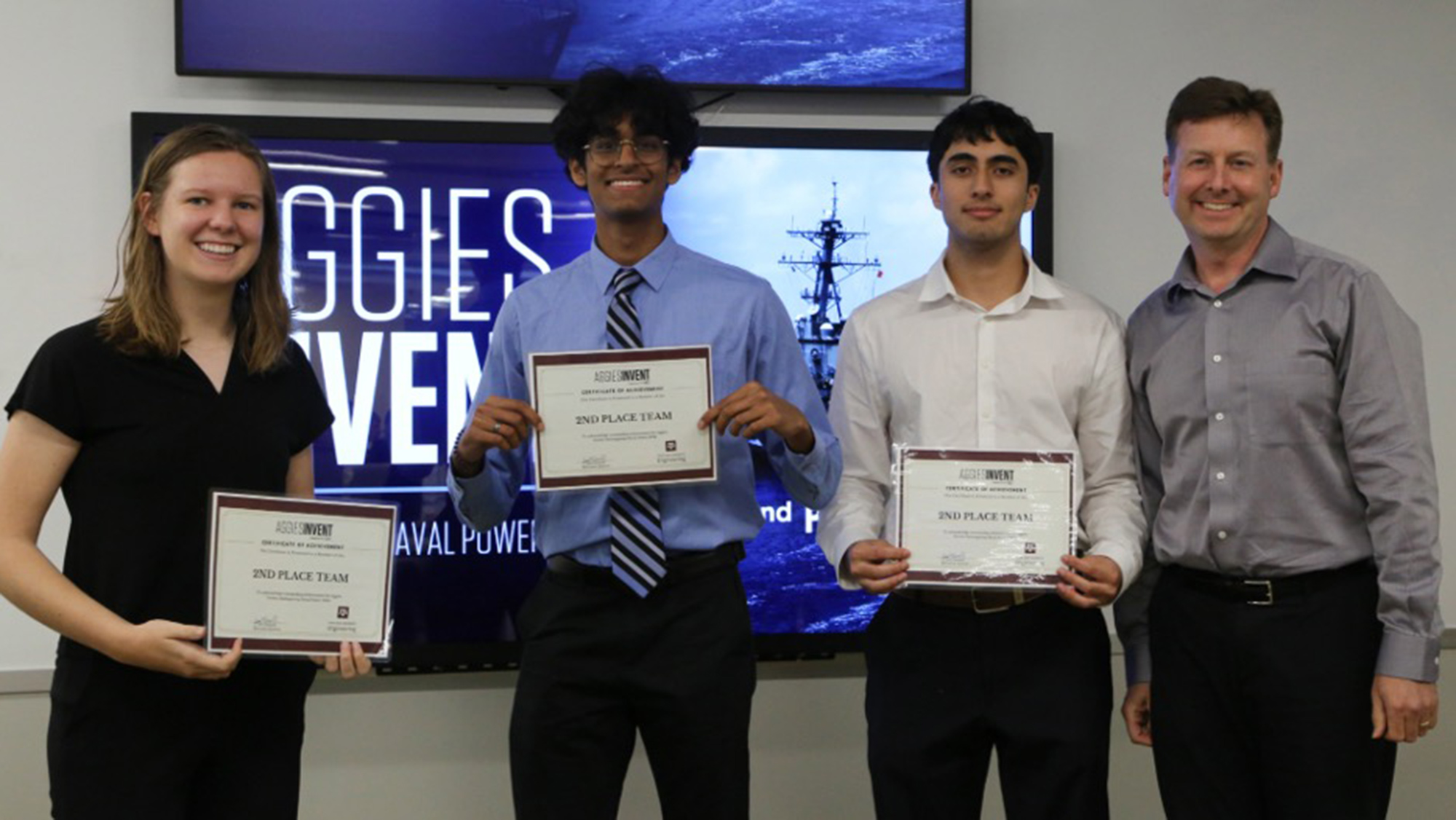The Meloy Engineering Innovation and Entrepreneurship Program hosted an Aggies Invent sponsored by the Office of Naval Research to explore innovations shaping the future of naval technology. During Aggies Invent: Reimagining Naval Power, 26 Texas A&M engineering students spent 48 hours conceptualizing a range of solutions for optimizing naval operations.
As noted by facilitator Chris Finberg in opening remarks, the students participating in this Aggies Invent navigated multiple unforeseen roadblocks throughout the design process. As one team grappled with 3D printing challenges, prompting a last-minute pivot to their contingency plan, another group returned from lunch to discover the whiteboard which had displayed their full prototype outline had been accidentally erased, sending them back to square one.
Finberg emphasized how personal and professional development is often found in working under a great amount of pressure — something sailors and marines know very well. “This was a fairly unusual Aggies Invent, but we are incredibly proud of your ability to adapt and overcome,” Finberg said.

Currently, the process for saving a sailor who has fallen overboard begins when a watchman observes the incident, raises an alert, and gathers a crew to initiate search and rescue protocol. First place winners, team Neptune’s Watch, recognized that eliminating the possibility of human error in man overboard operations and implementing simple uniform alterations could enhance safety measures for servicemen at sea.
Neptune’s Watch developed a three-pronged approach to solving these problems which they coined the “trident.” Neptune's Net would serve as the first line of defense — a thermal geofence that would recognize when a warm body has crossed the boat’s external radius. Neptune’s Watch, a wristwatch that detects submergence in salt water, would work in tandem with Neptune’s Net, as alarms only sound when both situations are present. To mitigate risk in dangerous rescue operations, an autonomous vehicle called Neptune’s Seal would deploy, supplying vital aid such as a raft, survival kit and GPS tracker.
“Our prototype started with a brainstorming session; everyone contributed all the ideas we had, and from there we selected the best components of each idea and combined them,” said Alberto Rodriguez, a master’s student in civil engineering. “I chose this Aggies Invent because the issues we’re solving hit very close to home. I've been an active-duty naval officer for ten years so it means a lot to me that we find an effective solution.”

The opportunities present in leveraging different forms of energy to power lightweight autonomous vehicles are promising. Hybrid propulsion seeks to combine the benefits of using both batteries and another power source in tandem to create more durable, sustainable flights for small tactile aircraft.
Second place winners, team Hydro Magnetix, engineered an innovative process of powering unmanned aerial vehicles (UAV). Their breakthrough involved integrating a magnetohydrodynamic (MHD) drive — a parallel propulsion system using a magnetic field perpendicular to an electric force — into a battery-powered vehicle, enhancing its capabilities in the air and at sea.
Team Hydro Magnetix prioritized scalability in their design as they ensured that the MHD drive could be retro-fitted to all current UAV models, arguing that widespread use of their parallel hybrid propulsion system would be cost-effective, discrete and efficient for long-range missions, especially in hazardous or remote areas.
In reflecting on his experience brainstorming with teammates to create the prototype, Rishi Khot, a biomedical engineering student, stated, “I learned that it’s important to think far outside the box, and from there, build back inwards.”

While vital, search and rescue operations looking for a lost warfighter are extremely dangerous and can last for days.
Team SeaCall sought to tackle this issue and enhance personnel safety with their innovative watch application and wearable personal flotation device. The watch would function as normal, with an added feature of detecting rapid pressure, altitude and acceleration changes.
The prototype came to life as Benjamin Workman, a biomedical engineering student, demonstrated its functionality. Upon detecting specific conditions, the watch would transmit a discreet location signal, while simultaneously a small CO2 tank integrated into a uniform attachment would activate, deploying a personal flotation device.
“There was a lot of thinking on the fly and figuring out how we could express our ideas with the limited time and resources we had,” said Workman on the process of developing a working prototype. “I think that Aggies Invent is a pretty unique situation where you’re going in fairly blind, and by the end of a 48-hour period you have a whole project to show for it. It’s a really awesome feeling.”